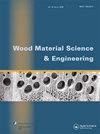白腐菌和褐腐菌对木纤维毡增强复合材料化学成分、结晶度和微观结构的影响
IF 2.1
3区 农林科学
Q1 MATERIALS SCIENCE, PAPER & WOOD
引用次数: 4
摘要
木纤维垫增强复合材料(WFMRC)是一种新型的工程木基聚合物复合材料,用于装饰和建筑应用。真菌腐烂严重影响木质复合材料在室外环境中的使用寿命。本研究通过真菌耐久性试验研究了白腐真菌(Trametes versicolor)和褐腐真菌(Gloeophyllum trabeum)对两种不同木材(杨木和落叶松)制成的WFMRCs的化学成分、结晶度和形态的影响。在真菌侵染12周后,杨树WFMRC的质量损失(分别为18.3%和18.4%)大于落叶松WFMRC的质量损失(分别为11.4%和18.4%)。化学分析和傅里叶变换红外光谱测量表明,真菌降解后,WFMRCs对全息纤维素有降解作用。x射线衍射分析表明,真菌腐烂增加了杨树WFMRC的结晶度,而降低了落叶松WFMRC的结晶度。在杨树WFMRC中,朽木细胞壁上出现孔洞,细胞壁变薄,细胞塌陷。虽然WFMRC可以被归类为抗真菌腐烂,但应考虑采取适当的保护措施来提高WFMRC的室外耐久性。本文章由计算机程序翻译,如有差异,请以英文原文为准。
Changes in chemical composition, crystallinity, and microstructure of wood fiber mat-reinforced composite caused by white-rot fungus Trametes versicolor and brown-rot fungus Gloeophyllum trabeum
ABSTRACT Wood fiber mat-reinforced composite (WFMRC) is a novel type of engineering wood-based polymer composite for decorative and building applications. Fungal decay strongly influences the service life of wood composites in outdoor environments. In this study, fungal durability tests were conducted to investigate how white- and brown-rot fungi (Trametes versicolor and Gloeophyllum trabeum, respectively) affect the chemical composition, crystallinity, and morphology of WFMRCs made from two different wood species (poplar and larch). The poplar WFMRC lost more mass (18.3% and 18.4% by T. versicolor and G. trabeum, respectively) than the decayed larch WFMRC (11.4% and 18.4% by T. versicolor and G. trabeum, respectively) after 12 weeks of fungal exposure. Chemical analysis and Fourier-transform infrared spectroscopy measurement revealed the degradation of holocellulose of the WFMRCs after fungal decay. X-ray diffraction analyses demonstrated that fungal decay increased the crystallinity of the poplar WFMRC but decreased the crystallinity of the larch WFMRC. Bore hole formation on the walls of wood cells, cell wall thinning, and collapsed cells were found in decayed samples, particularly in the poplar WFMRC. Although the WFMRCs could be classified as resistant to fungal decay, an appropriate protective measure should be considered to improve the outdoor durability of the WFMRC.
求助全文
通过发布文献求助,成功后即可免费获取论文全文。
去求助
来源期刊

Wood Material Science & Engineering
Materials Science-General Materials Science
CiteScore
3.90
自引率
13.60%
发文量
131
审稿时长
79 days
期刊介绍:
Wood Material Science and Engineering is a multidisciplinary and international journal with the aim to serve at the forefront of the wood science and technology field. The journal publishes original articles on basic and applied research dealing with:
-Wood material science with emphasis on: water-wood relations, wood durability, wood modification, wood mechanics, wood composites, engineered wood products, energy conversion and eco-efficient wood based products.
-Wood engineering, i.e. the application of the wood material science to designing, processing and manufacturing of forest products and the use of machines and processes for these products. Products of concern are biofuels, sawn wood and further refined products such as structural elements, interior fittings and furnishings. In this aspect the link between the nature of the wood material and the properties of the final wood products in-service and its impact on the environment is of outmost importance.
High quality review papers may also be accepted but the topic should be discussed with the editor before submission.
 求助内容:
求助内容: 应助结果提醒方式:
应助结果提醒方式:


